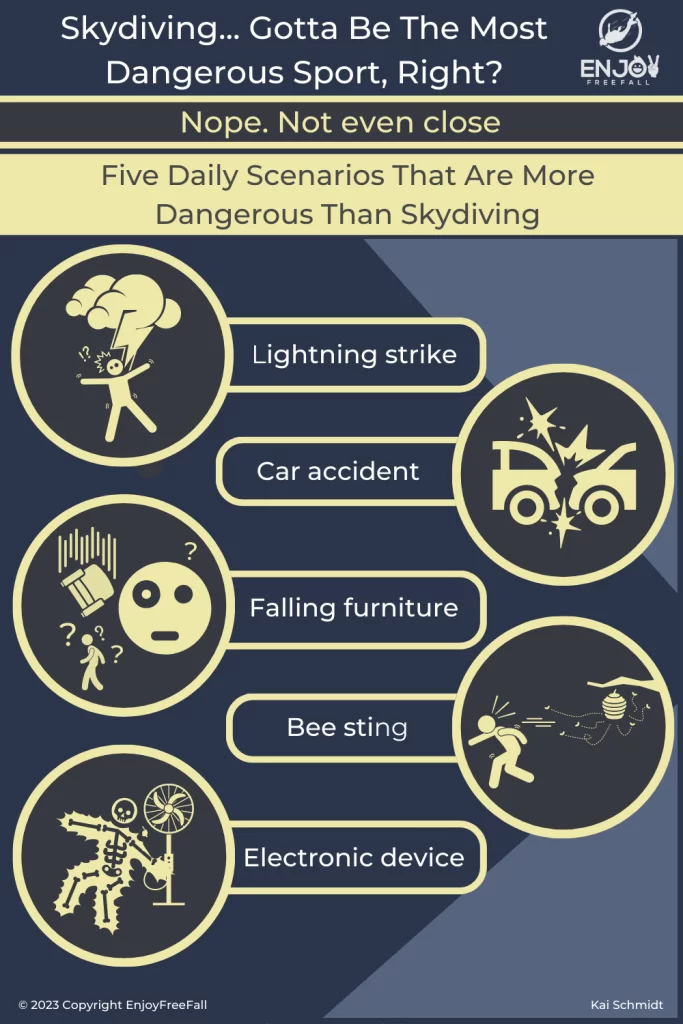
Skydiving is quite scary for most people because you jump out of an airplane at 12,000ft and trust the parachute – basically a piece of nylon – to land safely. If the parachute and the back-up parachute do not work properly you will most certainly die. But how often do both parachutes actually fail?
According to the USPA, both parachutes fail 0.45 times in 100,000 skydiving solo jumps and one time in every 500,000 tandem jumps. This corresponds to a likelihood of a double parachute failure of 0.00045% for solo jumps and 0.0002% for tandem jumps.
In other words, you can perform 220,000 skydiving solo jumps before you will encounter a double parachute failure. This means jumping 5 times a day for 102 years straight without having a double parachute failure.
However, the official statistics do not only count parachute malfunctions as parachute failures but include human error as well (e.g. when a skydiver was not able to deploy his reserve system properly and in time). In order to find the “true” likelihood, I checked the USPA databases manually, and here is what I found. I have also researched five daily scenarios that are more likely to kill you than a double parachute failure.
Risk of Double Parachute Failure On A Skydive
Although parachute failure seems like the greatest danger when skydiving – it is far more unlikely than you would expect it to be. (We are just tremendously biased due to the Youtube videos where some malfunction occurs and the skydiver resolves the problem at last resort).
If you are curious about when parachutes fail to open, you can check out my article, which explains the 13 most common reasons why parachutes fail. It also includes surprising tips and tricks to avoid parachute failure!
According to the USPA, the likelihood that the first parachute will not open is approximately 0.1% which means that one in every one-thousand parachutes will not open. This is approximately the same as catching a foul ball during a professional baseball game – you have seen it on TV and maybe also in the baseball stadium but probably you have never been the lucky one.
Would you like to know who is responsible for skydiving investigations? Then read my article about who investigates skydiving accidents.
As you see, it is already an extremely unlikely scenario that your first parachute will not open but even more so that you will encounter it on your first jump.
That being said, if you start jumping regularly, it is not extremely unlikely for you to encounter the main parachute failure or to meet someone who had to cut off the main parachute and deploy the reserve parachute. So it is important to follow the safety training and be ready to cut-off the main parachute and to deploy your reserve system.
Even if the first parachute fails, skydivers are still equipped with the back-up parachute. The likelihood that the reserve system does not open is practically non-existent. I checked the USPA database and found 5 incidents of malfunctioning back-up parachutes between 2010-2020. Within this time, there were 29.1 million jumps performed.
Mathematically speaking, this would mean that the likelihood of a malfunction with the reserve system is around 0.017% i.e. one in every 5,820 jumps. To put this into perspective, you are approximately twice as likely to be hit by a meteorite than to experience a failure in your reserve system.
In order to find out the final likelihood of a double parachute failure (excluding human errors), you would need to multiply the likelihood that the first parachute fails (0.1%) with the likelihood that the reserve parachute fails (0.017%) which corresponds to a likelihood of 0.000017%.
In other words, it is still more likely that you will catch the foul ball during the next baseball game and will be hit by a meteorite immediately after it than to experience a double parachute failure.
Why The Reserve Parachute Is Much Safer Than the Main Parachute
Back-up parachutes are much more reliable than the main parachutes due to their special design and strict packaging rules. While the design of the main parachutes balances a trade-off between performance and reliability, reserve parachutes optimize solely for safety. This means that the backup system almost never fails, and is much less comfortable when deployed.
The main difference in the design between the main and reserve parachutes is that the deployment system of the main parachute is attached to the parachute. This is more convenient because you do not lose your deployment system after every jump. However, it can cause problems such as line entanglement which stops the parachute from inflating. Reserve systems in contrast do not attach the deployment systems to the parachute to rule out the possibility of line entanglement.
The second main difference lies in the packaging of the parachute. While skydivers package their canopy themselves, the reserve system is packaged by FAA certified senior riggers. It might sound strange to you but skydivers often get sloppy in their packaging over time. Because they have already done hundreds of jumps without any problems they do not pay close attention to the packaging anymore. This can result in improper packaging which prevents the parachute from opening.
I know that it sounds silly to put your life in danger because you do not pay close attention to the packaging, however, you get a certain routine over time so that you underestimate the risk of wrong packing. (It is probably comparable to warning lights on your car that you might have ignored for the past weeks)
In contrast, you are not allowed to package your reserve system yourself. They have to be packaged by an FAA-certified rigger who has undergone extensive training to make sure that no mistakes happen. The reserve parachute is also repackaged every 180 days such that it gets even safer.

The Major Cause of Skydiving Accidents Is Not Parachute Failure
In fact, double parachute failure is not the greatest danger when skydiving. I have summarized some risks that are greater than a double parachute failure.
No Pull/Low Pull – Not pulling a parachute will definitely result in death, however, a low pull can also be fatal. It happens when skydivers do not pay close attention to their altitude or when they want to test their own limits. The absolute minimum altitude an experienced skydiver should open the parachute is 1,200ft. If you are interested in knowing more about the absolute minimum altitude to open the parachute and the world records, you can find more information in this post.
Entanglement – One of the greatest risks is that you open the parachute and it does not inflate properly due to line entanglements. Line entanglements usually happen due to wrong packaging, improper equipment maintenance, or when releasing in the wrong or an unstable position.
Collision with other parachutes – Specifically, when many people jump at the same time e.g. during formation jumps, their canopies might collide. This can result in an entanglement between their parachutes which leaves them unable to fly. It can also happen that one skydiver is knocked unconscious during the collision so that he cannot follow emergency procedures and deploy his back-up parachute.
Freefall collisions – Even though it is similar to the canopy collision, freefall collision often does not result in fatal damages. Most of the time, skydivers do not hit each other so strongly that one is knocked unconscious.
Landing problems – Landing problems occur when people land off the drop zone in unknown areas. They might hit some electronic fences, stones, or barbed wire which either results in injuries or death. In recent years, there has also been a spike in fatalities due to high-performance landings where people try to land as fast as possible.
Medical conditions – Although this is rare as well, some skydivers perform a jump even though they feel unwell. The mental stress/adrenaline kick together with unwell conditions might result in unconsciousness or a heart stroke. So if you ever feel unwell, do not jump!
As you can see, most accidents happen due to human error. This is also the reason why tandem jumps are so much safer than solo jumps. When jumping tandem, you will have an experienced instructor who deploys the parachute, resolves any problems, and lands you safely.
If you want to know more about the difference between safety on tandem and solo jump, this post will help you.
Five Daily Scenarios That Are More Dangerous Than Skydiving
You already know that you are more likely to catch a foul ball and to be hit by a meteorite at the same time than to encounter a double parachute failure. But how risky is skydiving in general? In short, it is one of the safest sports in general. In order to put the risk into perspective, I have summarized five daily risks that are more likely to kill you than skydiving:
- You are more likely to be struck and killed by lightning
- You are more likely to be killed in a car accident (or on your way to the drop zone)
- You are more likely to be killed by falling furniture
- You are more likely to be killed by a bee struck
- You are more likely to be electrocuted by a malfunctioning electronic device
With that being said, there is nothing in your way for your next jump!
Enjoy your free fall!



